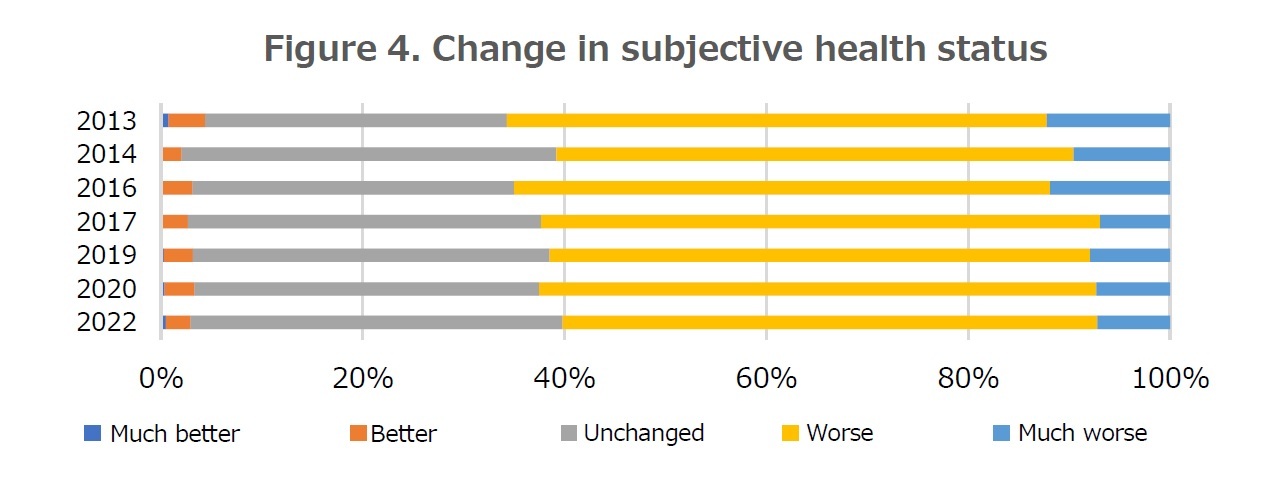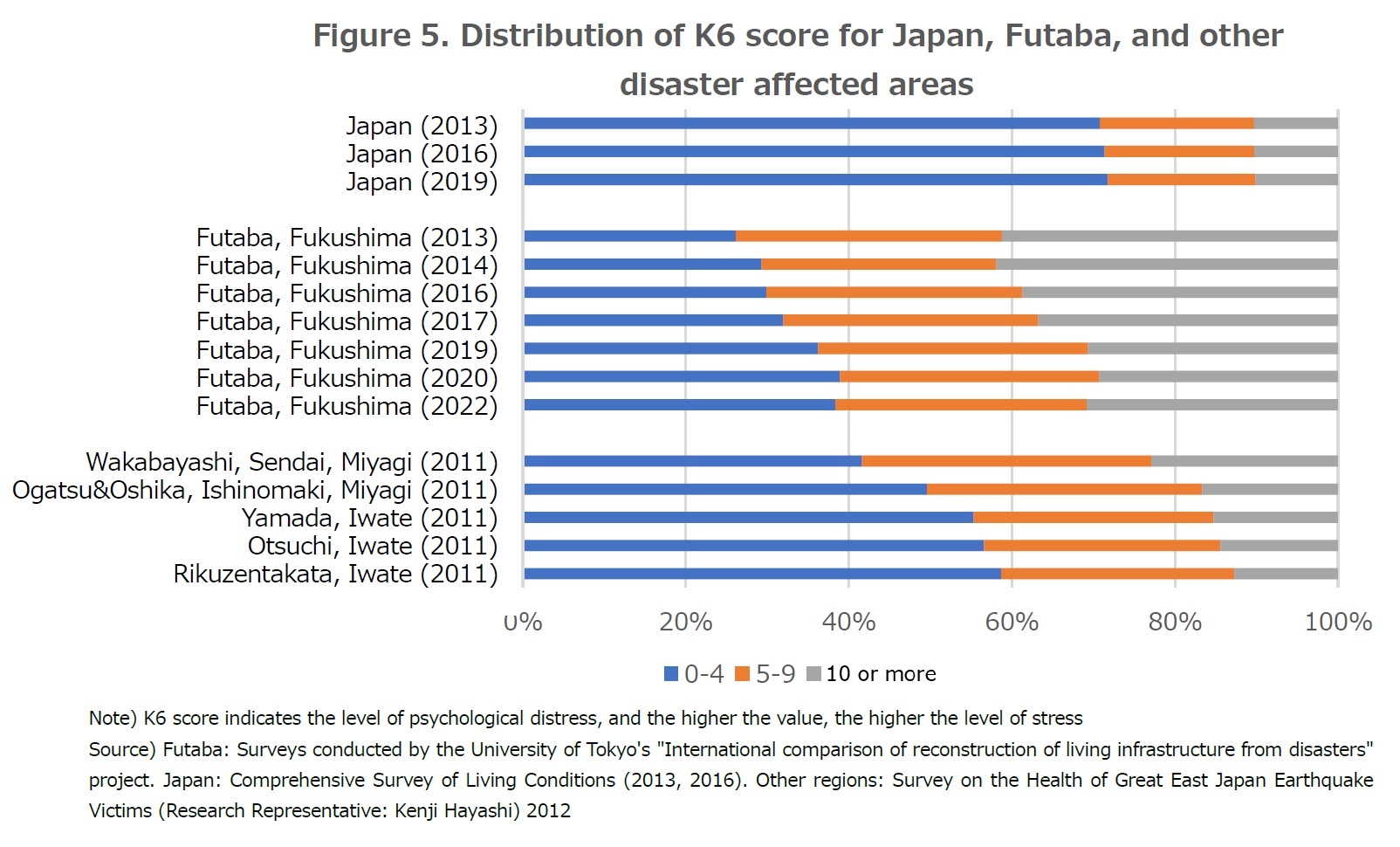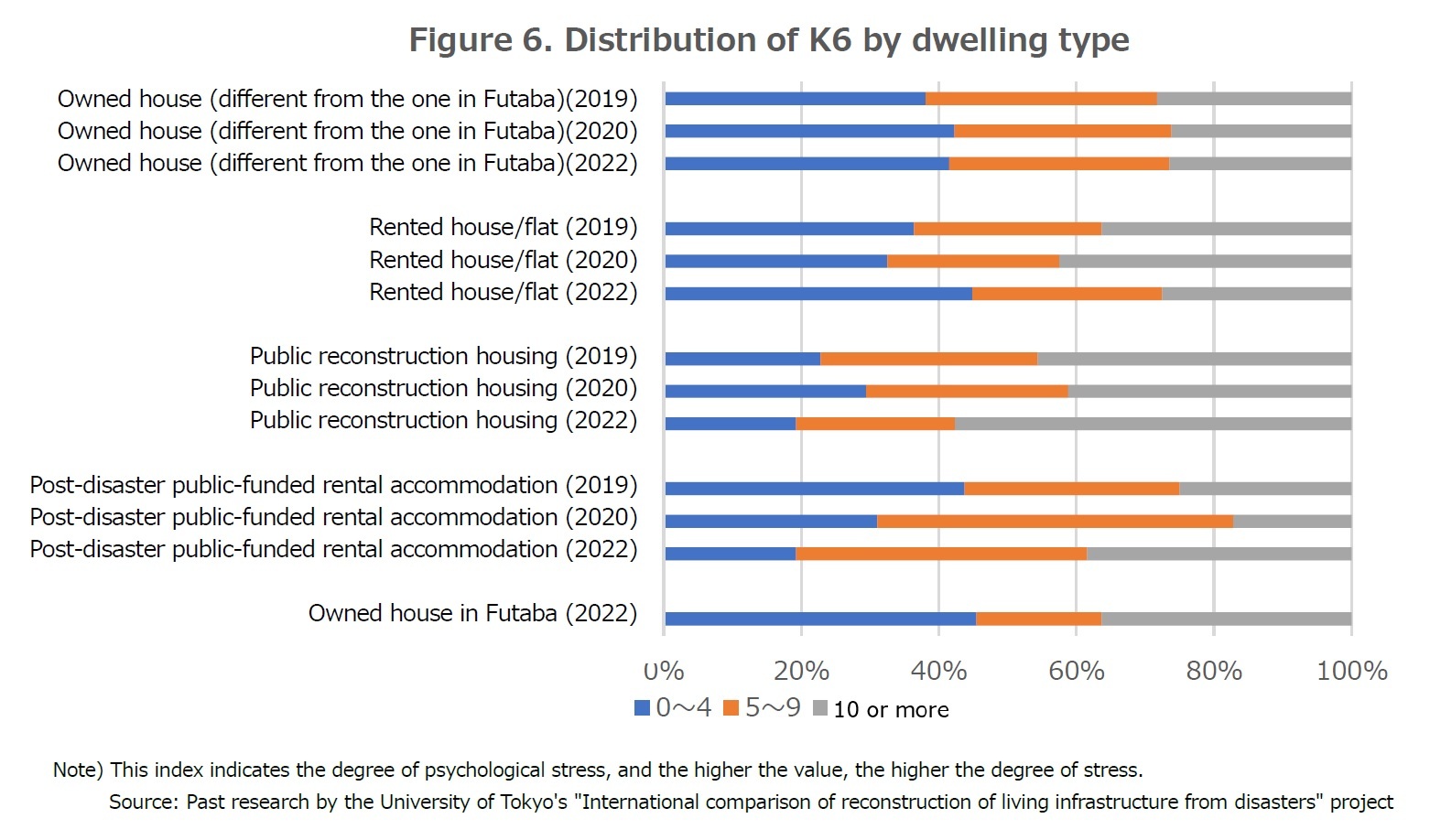- NLI Research Institute >
- Life >
- Summary Results of the 7th Survey of Nuclear Disaster Evacuees from Futaba, Fukushima-The First Survey since the Start of Return*-
01/03/2023
Summary Results of the 7th Survey of Nuclear Disaster Evacuees from Futaba, Fukushima-The First Survey since the Start of Return*-
Damage, Living Environment, and Reconstruction under the Great East Japan Earthquake
Insurance Research Department Keiko Iwasaki
Font size
- S
- M
- L
1――Basic Information
Surveys on damage, living environment and reconstruction under the Great East Japan Earthquake have been conducted by a research project, "International comparison of reconstruction of living infrastructure from disasters" (Yasuyuki Sawada, Professor, Faculty of Economics, The University of Tokyo; Keiko Iwasaki, Researcher, NLI Research Institute) of the University of Tokyo since 2013. The surveys are targeted to all household heads of Futaba in Fukushima prefecture, where all residents were forced to evacuate due to the nuclear power plant accident caused by the Great East Japan Earthquake occurred in 2011. Surveys were conducted in July 2013, December 2014, July 2016, December 2017, July 2019, December 2020 and October 2022. This paper reports the summary of results of the seventh survey conducted in October 2022.1Since the evacuation order of a part of the town of Futaba was lifted on August 30th, this is the first survey conducted after Futaba residents started returning to home among the past seven rounds of surveys.
The survey includes questions about basic attributes such as age and sex, as well as questions related to connections with others (social capital) and health conditions (See appendix at the end of this report for all the questions included in the survey). The questionnaires were distributed to all households of Futaba (About 2,900 households) that receive the regular town mail from Futaba. We also distributed simplified version of the questionnaires excluding questions inquiring about already available information from previous rounds of surveys to those who had filled out names and addresses in previous surveys (617 people). We received responses from 653 Futaba residents who had evacuated nationwide (292 responses from questionnaires included in the town mail, 361 responses from the simplified version of the questionnaires. Response rate is about 23%).
Figures 1 and 2 show the distribution of age and sex of the respondents. The target of this survey is household heads. As we can see from these figures, compared to the age and sex distribution of Futaba reported in the national census, the age distribution of the respondents is left-skewed, with the majority of respondents are over late 60s. The sex distribution of the respondents shows that the majority of respondents are male. In addition, since the survey was conducted after the tremendous disaster, it is possible that the distributions of the respondents' characteristics are significantly different from those of general questionnaire surveys. Therefore, it should be noted that the results of this survey do not necessarily indicate the general trend of Futaba residents.
Figures 1 and 2 show the distribution of age and sex of the respondents. The target of this survey is household heads. As we can see from these figures, compared to the age and sex distribution of Futaba reported in the national census, the age distribution of the respondents is left-skewed, with the majority of respondents are over late 60s. The sex distribution of the respondents shows that the majority of respondents are male. In addition, since the survey was conducted after the tremendous disaster, it is possible that the distributions of the respondents' characteristics are significantly different from those of general questionnaire surveys. Therefore, it should be noted that the results of this survey do not necessarily indicate the general trend of Futaba residents.
1 This research has been supported by the following research grants.
Grant-in-Aid for Scientific Research (15 J09313, 26220502, LZ003), Research Grants of the Japan Center for Economic Research, The Univers Foundation Research Grant (2021).
This study is approved by the Ethics Committee of the University of Tokyo (21-329).
2――Health conditions
Regarding health condition, as shown in Figure 3, many rated their own health condition before the earthquake as "good" or "very good" while many rated their current health status as "bad," "terrible" or "can't say either way". Compared to the 2016 survey result, the portion of respondents who rated their current health status as "good" had been increasing till 2020 survey, while the portion of respondents who rated their current health status as "bad" decreased slightly, indicating that overall health status of Futaba residents had been gradually recovering. However, we could not observe the recovering trend between 2020 and 2022. In addition, as shown in Figure 4, when asked about changes in health condition compared to pre-disaster status, more than half of the respondents rated their own health condition as worse than that of pre-disaster status and the distribution has hardly changed since 2013.
As to mental health, we overview the distribution of K6 score, a clinically validated index for diagnosing the overall stress state. K6 is an internationally used measurement for general mental health status that consists of six questions. The higher the total score, the more likely the respondent is stressed2. The distribution of the K6 score of Futaba residents had been gradually improving from 2013 to 2020 (See Figure 5). However, we could not observe improving trend between 2020 and 2022. Furthermore, the scores of Futaba are still higher than those in the other disaster affected areas, indicating that mental health recovery of Futaba may take a very long time.
In addition, the previous rounds of surveys between 2013 and 2017 showed that K6 score among Futaba residents living in temporary shelters had been increasing year by year3. However, only few lived in temporary shelters among respondents of the surveys conducted in 2019 and later (6 respondents in 2019 survey, 7 respondents in 2020 survey, and 4 respondents in 2022 survey lived in temporary shelters) because many who used to live in temporary shelters had moved to public reconstruction housings. Therefore, instead of checking the distribution of K6 score among temporary shelter residents, we have been comparing the distribution of K6 score by dwelling type except for temporal shelters such as owned house and public reconstruction housing since 2019. As shown in Figure 6, K6 score among residents of public reconstruction housings tend to be higher than that of residents who live in owned houses. Also, K6 score among residents of post-disaster public-funded rental accommodation have been increasing year by year. These results suggest the importance of continuous mental health support for those who live in post-disaster public-funded rental accommodation and public reconstruction housings. Also, since the survey conducted in 2022 was the first survey conducted after Futaba people could at last start to move back to the town of Futaba in August 2022, there are repspondents who live in a house in Futaba where they originary lived before the disaster. The distribution of K6 score of those who live in their own house in Futaba is shown in figure 6 for your reference. Even though the the number of the respondents who live in their own house in Futaba are small (11 respondents), the distribution shows that residents seem to be dichotomized to those whose stress are low (blue area) and those whose stress are high (gray area).
However, the results of this survey do not necessarily apply to all residents of Futaba, and high K6 score does not necessarily mean that one has a mental disorder. Please note that the purpose of our survey is to provide policy implications.
However, the results of this survey do not necessarily apply to all residents of Futaba, and high K6 score does not necessarily mean that one has a mental disorder. Please note that the purpose of our survey is to provide policy implications.
2 Kessler, R. C., Andrews, G., Colpe, L. J., Hiripi, E., Mrockzek, D. K., Normand, S. L., Walters, E. E., Zaslavsky, A. M., 2002. Short Screening Scales to Monitor Population Prevalences and Trends in Non-Specific Psychological Distress. Psychological Medicine 32, 959-976.
Furukawa, T. A., Kawakami, N., Saitoh, M., Ono, Y., Nakane, Y., Nakamura, Y., Tachimori, H., Iwata, N., Uda, H., Nakane, H., Watanabe, M., Naganuma, Y., Hata, Y., Kobayashi, M., Miyake, Y., Takeshima, T., Kikkawa, T., 2008. The Performance of the Japanese Version of the K6 and K10 in the World Mental Health Survey Japan. International Journal of Methods in Psychiatric Research 17, 152-158.
古川壽亮 他. (2003). 一般人口中の精神疾患の簡便なスクリーニングに関する研究. 厚生労働科学研究費 補助金厚生労働科学特別研究事業
「心の健康問題と対策基盤の実態に関する研究」研究協力報告書.
3 Iwasaki, K. (2019/2/7)NLI Research Report (in Japanese) https://www.nli-research.co.jp/files/topics/63613_ext_18_0.pdf?site=nli Accessed on 2022. 12. 5)

03-3512-1882
レポート紹介
-
研究領域
-
経済
-
金融・為替
-
資産運用・資産形成
-
年金
-
社会保障制度
-
保険
-
不動産
-
経営・ビジネス
-
暮らし
-
ジェロントロジー(高齢社会総合研究)
-
医療・介護・健康・ヘルスケア
-
政策提言
-
-
注目テーマ・キーワード
-
統計・指標・重要イベント
-
媒体
- アクセスランキング























